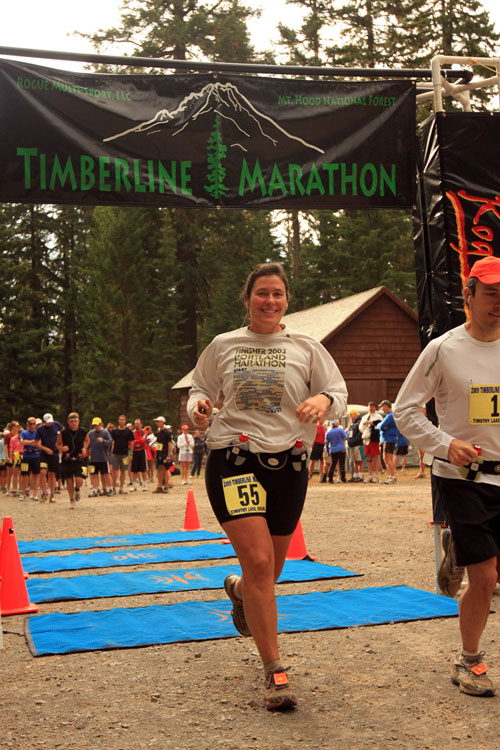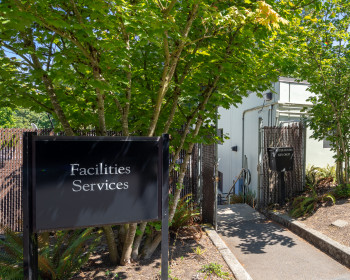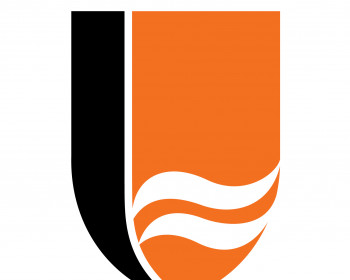Law Professor Maggie Finnerty runs for a cause
Since having a cardiac defibrillator and pacemaker implanted five years ago, Maggie Finnerty has been running fundraising races for the Heart Rhythm Foundation. Read more.
Open gallery

Last month, Maggie Finnerty, executive director and clinical law professor for the clinic, ran the Timberline Marathon—26.2 miles along the Timothy Lake Trails on Mt. Hood—as a fundraiser for the Heart Rhythm Foundation. Here, Maggie shares her motivation for running the race, and explains how she kept smiling all the way to finish line.
I ran for Heart Rhythm Foundation to help fund research to determine a genetic test for a condition that killed two of my brothers—a condition which I may also have.
As some of you may know, two of my brothers died in their sleep over 20 years ago. Kevin was 20; Timmy was 15. Both were high school and college athletes. The doctors could not determine what killed them, other than “some electrical condition” with their heart.
For 20 years, we wondered what happened, and who would be next. But about 6 years ago, my mother was diagnosed with a condition called “non-sustained ventricular tachycardia” and the doctors are certain it is what killed Kevin and Timmy. However, there is no definitive test for it. Some tests can tell if you definitely have it, but a negative reading doesn’t mean you definitely don’t have it—just the condition didn’t manifest during the testing.
Since the doctors can’t be sure if I have the condition, I had a cardiac defibrillator and pacemaker implanted over five years ago. And I began doing fundraising races to help find a more definitive diagnostic (and maybe genetic) test.
On Saturday, September 19, I ran the Timberline Marathon. The course traditionally leaves from Timberline Lodge and follows the Pacific Crest Trail down to Barlow Pass, Frog Lake, then to Timothy Lake. But due to permitting issues in the wilderness area, the race director had to change the course to two laps around Timothy Lake. I originally thought the course change would make the course easier—but I was wrong! I’ve done 2 other marathons, both of which took 4 hours and 20 minutes—but since this was a trail run, I knew it would take me longer than that, and I was hoping to finish the race somewhere around 4:30-4:45.
The race started around 8:30 a.m. on Saturday morning. The temperature was in the low forties, and the sky was overcast. We knew rain was on the way. While rain isn’t ideal, it’s much better than running on a hot, sunny day. My friend Mark and I had done most of our long runs together, and we planned to stick together throughout the race. We started together in the 4:30 group…shortly after we started, it began to rain, but because we were on the trail, we were fairly protected by the trees, and for the first 6 miles, we were going at a pretty good clip. But then the trail started to climb up hill…for the next 5-6 miles! Much of the trail was smooth, but there were some pretty muddy sections and several long stretches of rocky terrain where we had to be pretty careful—especially because it was wet from the rain.
Around mile 9 or so, my head started to tell me that the course was too hard…not even half-way done, I was WAY more tired than I’d expected to be and started to think that maybe I should switch to the half marathon…But then I thought of why I was running, the money I’d raised, and the support and encouragement my sponsors had given me.
One of my sponsors actually came up with a calculation: every $25 I raised was approximately 1⁄4 of a mile. I had no idea if that calculation was correct, but it gave me something to think about while I ran…doing math, counting people and dollars, and it really helped tick away the last few miles of the first loop.
Once I started the second loop (and the option of only doing a half marathon was gone), I felt much better. We picked it up a bit for a couple of miles, but then Mark started to have stomach problems. Because this was a trail run, there was very limited support, so we slowed it down for the next several miles before the next aid station. When we finally got there (around mile 18), we stopped for about 10 minutes using the “facilities” and filling our water bottles. Unfortunately, my quads started to tighten during the break, and when we started running again, my legs felt really heavy—and sore!
But we kept going—up the long uphill section (again!), and around then over the dam. We knew we’d make it, but our time was a lot slower than we had expected. We kept plugging along, walking up some of the steeper hills and trying to stay “happy runners” (our training mantra!), and finally we came to the turn off towards the finish line. I think the race directors have a terrible sense of humor, because the last mile and a half is about 3⁄4 of a mile up a very steep hill, then 3⁄4 mile of slightly up hill. Knowing the finish line was so close was great, but boy, it was hard to keep smiling up that hill!
Finally, we could see the finish line tent and we picked it up a bit to “look strong” for our finish, even though we felt far from strong! It was HARD. Way harder than either of us expected it to be—finishing in 5:15, I’ve never run for so long in my life!
But we did it. At the finish line, we each treated ourselves to a short massage, then went back to the house we rented, showered, and went to a local pub for a beer and some food. Then back to the house, took Chloe (my three-year-old golden retriever) for a short walk, and just relaxed for the rest of the night. Sunday morning, we got on our mountain bikes to spin out our legs and try to shake the lactic acid out—and to finally give Chloe some much-needed exercise.
By Sunday night, I was pretty sore! But it was worth it. These sorts of events aren’t supposed to be easy. They are a challenge—physically, emotionally, and in my case, financially. So far, I’ve raised about $4400 and I’m hoping a few more people will still sponsor me, so I just might make my goal of raising $5,000.
If you are interested, you can view pictures of Mark and I (he was #1, I was #55) at the following link:
http://www.backprint.com/view_user_event.asp?PID=bp%1ExNv&EVENTID=57930&PWD=&BIB=55
Many thanks to all you who supported me. I honestly thought about each and every one of you while I was running—every time I thought I might not make it—every time I could feel my bunions bleeding or another muscle spasm. I am really glad the race is behind me…and am already thinking about what race to do next year!
To share your uncommon journey with The Source, write to source@lclark.edu.
More The Source Stories
email source@lclark.edu

